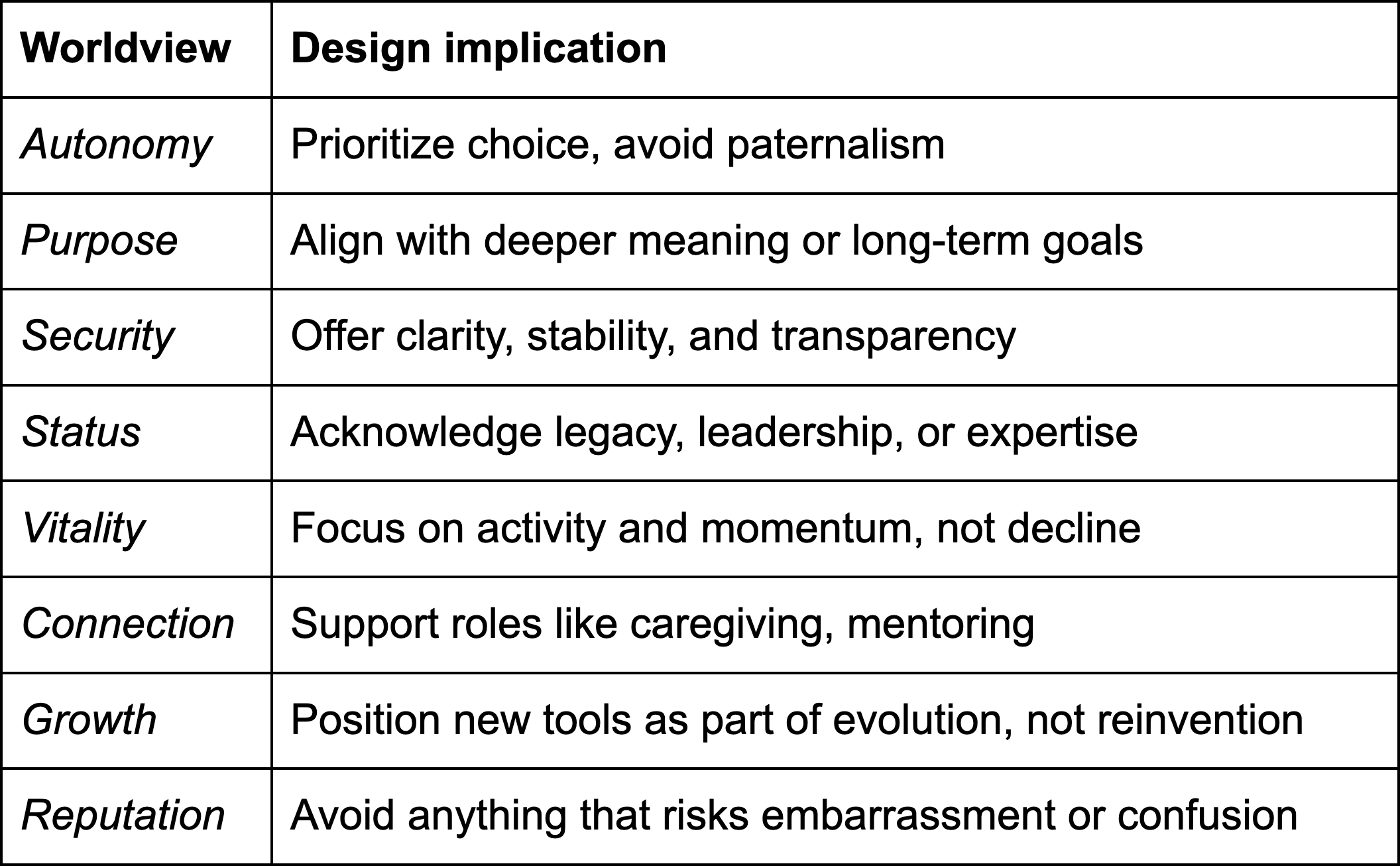By 2030, one-third of Americans will be over 50 years old. That’s more than 120 million people — and most of them aren’t who we think they are.
When we hear “older adults,” we often imagine people in their 70s or 80s who struggle with technology. However, the real 50+ audience includes Gen Xers who built the web, older Millennials nearing age 50, and Boomers who continue to shape culture and the workforce.
They’re not digital immigrants. They’re digital pioneers. And yet, we still design content that underestimates their fluency, sidelines their goals, and shrinks their agency. This article examines how we can challenge stereotypes, adopt research-backed personas, and shift our approach to writing for empowerment and identity, rather than focusing on age.
Designing for decline vs. designing for identity
Many of the patterns we call “senior-friendly” are actually age-biased. Instead of reflecting curiosity, competence, or autonomy, content might assume decline by:
- Over-coaching the user
- Framing everything as “finally getting on track”
- Using a friendly but condescending tone
Those tropes are outdated at best. At worst, they’re a form of unintentional ageism. Ageism in UX content isn’t usually overt. In fact, it often comes from a place of empathy or desire to create accessibility. But when we assume older adults are a static, declining population defined by deficits, we design experiences that patronize or overexplain.
Here’s an example from a wellness app targeting “seniors”:
“Ready to finally get healthy? Let’s do this!”
This copy assumes two things:
- The user hasn’t been healthy up to now.
- They need a motivational push rooted in a youthful tone.
A more inclusive alternative might be:
“You know what works for your body. Let’s build on that.”
This isn’t just about voice and tone. It’s about respect. And it starts with understanding who we’re writing for.
Who’s in the 50+ cohort today?
Let’s zoom out for a moment. Here’s who we’re really talking about:
- Boomers in their 60s and 70s, many still working and actively shaping culture
- Gen Xers born between 1965–1980, now ages 45–60
- Older Millennials, the first of whom turn 50 in just a few years
This audience grew up on dial-up and DSL. They were the first to text, blog, torrent, and livestream.
One note about Silent Generation adults, now in their 80s and beyond: Many engage with digital services, but often with caregivers or adult children acting as proxies. Designing for 50+ means designing for the people they’re supporting, too.
Here’s the kicker. This isn’t a niche. Globally, individuals aged 50 and above represent a $22 trillion economic opportunity.¹ But our content often leaves them behind.
To write effectively for them, we need new mental models. We need to go beyond age and identify behavioral patterns and mindsets that reflect how people navigate later life.
Get more valuable content design articles like this one delivered right to your inbox.
Six personas shaping the new 50+
These personas are based on behavioral research, not outdated assumptions. You’ll notice none of them are defined by frailty, fear, or tech aversion. That’s intentional.
1. The Self-Reliant Seeker
Mindset: “I’ll figure it out myself. I always do.”
Motivated by: Autonomy, competence, control
Content cue: Empower, don’t instruct.
This user prefers to explore digital tools independently, even if they hit bumps along the way. Over-explaining or “hand-holding” copy turns them off. Instead, give them clear structure, the option to dig deeper, and minimal friction.
Use: “Customize your own plan.”
Avoid: “Don’t worry, we’ll walk you through it step by step!”
Real-world scenario: A 53-year-old small business owner used a budgeting app to manage cash flow. When the app launched a step-by-step tutorial that they couldn’t skip, they closed it and searched for the feature on their own. “I don’t need training wheels,” they said. “Just let me get to the controls.”
2. The Value-Driven Pragmatist
Mindset: “Is this actually worth it?”
Motivated by: Functionality, reliability, ROI
Content cue: Get to the point and back it up.
They’re digitally fluent but skeptical of fluff. Trendy language, vague benefits, or abstract promises won’t fly. What will? Clear features, transparent pricing, and honest expectations.
Use: “Track results in real time. No hidden fees.”
Avoid: “A game-changing journey for your financial goals.”
Real-world scenario: A 57-year-old freelancer evaluating project management tools clicked away from one product the moment it pitched “a revolutionary way to collaborate.” What kept their attention on a competitor? A simple feature grid, a demo link, and real pricing up front.
3. The Optimistic Adapter
Mindset: “I’m up for something new if it fits.”
Motivated by: Growth, curiosity, staying current
Content cue: Offer novelty with grounding.
This user embraces innovation but appreciates context. They’re not overwhelmed by technology, but they want to know how something aligns with their values or lifestyle before making a decision.
Use: “Try our newest feature and see how it compares to what you use now.”
Avoid: “The future is here! Are you ready?”
4. The Skeptical Convert
Mindset: “Convince me this isn’t a waste of time.”
Motivated by: Trust, transparency, social proof
Content cue: Build credibility fast.
This persona often comes from a background of poor or patronizing digital experiences. They need content that feels trustworthy, real, and respect-driven. Don’t use hype or high-pressure copy.
Use: “Rated 4.8 stars by 3,000+ people like you.”
Avoid: “Join the revolution!”
Real-world scenario: A 60-year-old operations director tried telehealth once and swore they’d never do it again. The UI froze, the instructions assumed they didn’t know how to click, and the “friendly” chatbot wouldn’t let them skip the basics. When they finally re-engaged with a new provider, it was because a friend shared screenshots of a clean, simple interface with no condescension in sight.
5. The Lifelong Learner
Mindset: “I’m never done learning. I just learn differently now.”
Motivated by: Mastery, purpose, intellectual growth
Content cue: Respect their intelligence.
This user may be exploring new tools for career reinvention, creative projects, or personal curiosity. They want content that’s informative, well-written, and worth their time — not simplified or condescending.
Use: “Read the full article, or save it for later.”
Avoid: “It’s easier than you think. We promise!”
6. The Empowered Caregiver
Mindset: “I manage more than just my own needs.”
Motivated by: Efficiency, empathy, multi-tasking
Content cue: Write for real-world complexity.
This persona often juggles their own digital experience with that of an aging parent, spouse, or child. Content must be usable, clear, and respectful of emotional load.
Use: “Switch profiles easily to manage care for someone else.”
Avoid: “This app is for you and your wellness.”
Real-world scenario: A 50-year-old project manager shared that they use the same task app to coordinate their team’s projects and manage post-surgery recovery tasks for their 79-year-old mom. They toggle between roles constantly and need tools that don’t assume they have the luxury of single-use focus.
Persona checkpoints for content review
When writing for older adults, ask:
- Does this reflect their experience, or does it patronize them?
- Would this tone resonate as well with a Gen Xer as it does with a 25-year-old?
- Am I empowering or over-explaining?
What empowering content really means
Empowering content assumes capability. It builds trust and invites autonomy. The 50+ audience, like any group, doesn’t want to be coddled or over-explained to. They want tools and messaging that treat them as experienced, thoughtful, and adaptable.²
Three content traps to avoid
Use this framework to spot and fix age bias in your content.
1. The “Helper” Trap
You assume older users need your guidance — and forget their autonomy.
This shows up in:
- Patronizing tones (“Don’t worry, we’ve got you!”)
- Step-by-step walkthroughs for tasks that may already be intuitive
- Overuse of success messages or “you did it!” feedback, which can come across as infantilizing
What to try instead:
Use language that suggests a collaborative and self-directed approach. Give users agency. Offer layered content (e.g., “learn more” links or optional guidance) so users can choose what they need.
Example rewrite:
Before: “We’ll walk you through everything. It’s easier than it looks.”
After: “Need help getting started? Explore tips from others who’ve used this feature.”
2. The “Wow Factor” Trap
You lean on hype, novelty, or FOMO and lose older users in the noise.
This shows up in:
- Trendy buzzwords or language rooted in youth culture
- Exaggerated claims (“The most game-changing tool ever!”)
- Assuming curiosity = readiness to adopt right now
What to try instead:
Lead with relevance and usefulness. Older users are more likely to ask, “How does this fit into my existing life or workflow?” They’ll try new things, but only if you connect the dots.
Example rewrite:
Before: “You’ve never seen anything like this before!”
After: “A new way to track your habits, built to fit how you already live.”
3. The “One Size Fits All” Trap
You design content for the average user, excluding everyone else.
This shows up in:
- Generic messaging that ignores life context (e.g., caregiving, health changes, career pivots)
- Assumptions about tech usage (“You’ll want to sync this with your smart home setup…”)
- CTA copy that treats all users as single-purpose personas
What to try instead:
Revisit your personas. Ask how this message would land with a Value-Driven Pragmatist or an Empowered Caregiver. Would the content still resonate?
Example rewrite:
Before: “Stay focused with reminders that keep you on track.”
After: “Set reminders for yourself or someone you support.”
Bonus tool: Apply these eight worldviews
Here’s a companion tool to layer on top of your persona work, to incorporate deeper decision drivers. Research indicates that decision-making in later life is often influenced more by identity and values than by demographics or technological fluency.³
These eight worldviews, identified by behavioral researchers, frequently show up in content journeys for the 50+ audience:

You already have the tools
You know how to write with clarity. You know how to build trust. You know how to ask the right questions. Now add the lens.
Designing for older adults isn’t about simplifying everything or creating a “senior version” of your digital experience. It’s about designing with respect, complexity, and care — just like you would for any other audience.
This isn’t an edge case. This is the mainstream. And it’s growing.
References
- AARP. “The Longevity Economy Outlook.” (2022).
- Mariano et al. “Too Old for Technology? Stereotype Threat and Technology Use by Older Adults.” (2022).
- Oxford Institute of Population Aging. “Technology Adoption in Later Life.” (2020).






